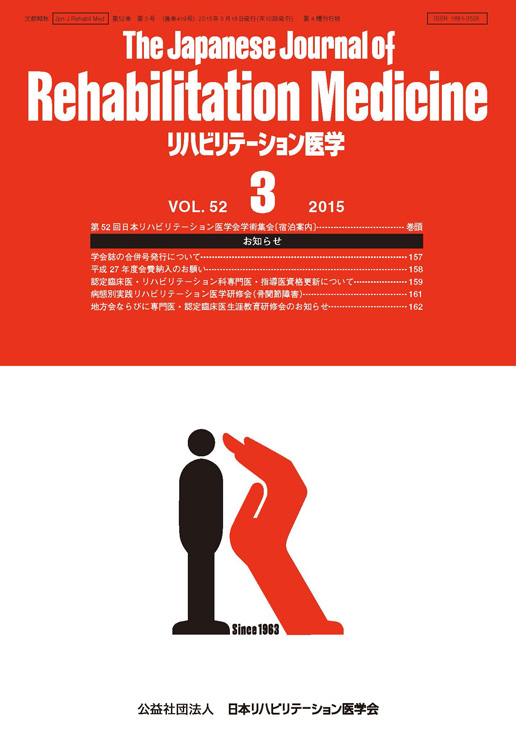All issues

Predecessor
Volume 52, Issue 3
Displaying 1-10 of 10 articles from this issue
- |<
- <
- 1
- >
- >|
51st Annual Meeting of the Japanese Association of Rehabilitation Medicine Symposium
-
2015 Volume 52 Issue 3 Pages 165-169
Published: 2015
Released on J-STAGE: April 23, 2015
JOURNAL FREE ACCESS
Robotic Therapy Intervention Using the Reo Go therapy systemTM…Takashi TAKEBAYASHI, Keisuke HANADA, Kazuhisa DOMEN 165View full abstractDownload PDF (1259K) -
2015 Volume 52 Issue 3 Pages 170-175
Published: 2015
Released on J-STAGE: April 23, 2015
JOURNAL FREE ACCESS
Activity-based Intervention for Dementia: Brain-activating Rehabilitation Prevents Both the Development and Progression of Dementia…Haruyasu YAMAGUCHI, Tetsuya YAMAGAMI, Tomoharu YAMAGUCHI, Tadahiko KAMEGAYA 170
The Challenge of Locomotive Syndrome…Astushi HARADA 173View full abstractDownload PDF (1017K) -
2015 Volume 52 Issue 3 Pages 176-188
Published: 2015
Released on J-STAGE: April 23, 2015
JOURNAL FREE ACCESS
A Kinesiological Viewpoint for Reconstruction Activities…Masaki ISE 176
Functional Reconstruction of Upright Stance and Gait Performance…Kimitaka HASE 181
Gait Reconstruction Using Robotics in Persons with Paraplegia…Shigeo TANABE, Satoshi HIRANO, Eiichi SAITOH 185View full abstractDownload PDF (2266K)
51st Annual Meeting of the Japanese Association of Rehabilitation Medicine Asian Symposium
-
2015 Volume 52 Issue 3 Pages 189-194
Published: 2015
Released on J-STAGE: April 23, 2015
JOURNAL FREE ACCESS
Collaboration and Teamwork in Rehabilitation Medicine in the Korean Healthcare System…Jae-Young LIM 189View full abstractDownload PDF (1413K)
Educational Lectures
-
Yasuharu KOIKE2015 Volume 52 Issue 3 Pages 195-197
Published: 2015
Released on J-STAGE: April 23, 2015
JOURNAL FREE ACCESSDownload PDF (535K) -
Shin-Ichi IZUMI2015 Volume 52 Issue 3 Pages 198-201
Published: 2015
Released on J-STAGE: April 23, 2015
JOURNAL FREE ACCESSDownload PDF (235K)
Case Report
-
Masachika NIIMI, Masahiro ABO, Satoshi MIYANO2015 Volume 52 Issue 3 Pages 202-206
Published: 2015
Released on J-STAGE: April 23, 2015
JOURNAL FREE ACCESSPatient 1, a 75-year-old woman with a past history of osteoarthritis of the right knee and Parkinson disease, had a subarachnoid hemorrhage. She complained of right knee pain during her rehabilitation. It turned out that she had sustained a right trochanteric fracture after falling out of bed in another hospital. Patient 2, an 86-year-old woman with a past history of rheumatoid arthritis, was treated with the Gamma nail technique for a left trochanteric fracture. She described experiencing pain in the region from the left knee to the lateral side of the left thigh during her rehabilitation, about two months after the hip operation. X-ray and computed tomography images showed varus displacement of the femoral head due to screw cut-out. In each of these cases, it took some time for us to detect the underlying hip diseases. The dermatome shows regions of the skin innervated by each single spinal segment. Similarly, the sclerotome shows regions of bone and periosteum innervated by each single spinal segment. According to Inman and Saunders's sclerotome, the proximal portion of the femur is mainly innervated by L3, L4 and L5. On the other hand, in dermatome perspective, L3, L4 and L5 innervate the knee and region around the knee. It means that hip diseases can cause referred pain to the knee. Untypical pain in distant regions from the hip joint makes it difficult to examine the hip joint and causes delay in an accurate diagnosis, as in the cases just described. Therefore, we should keep in mind that hip diseases can cause referred pain to the knee.View full abstractDownload PDF (942K)
Review Article
-
Tsuyoshi MIZUSHIRI2015 Volume 52 Issue 3 Pages 207-211
Published: 2015
Released on J-STAGE: April 23, 2015
JOURNAL FREE ACCESSIn recent decades, natural disasters have increased markedly. A large-scale disaster can cause not only severe injuries but also stress-related diseases such as cardiovascular events. Particularly, the elderly and persons with preexisting disabilities are at greater risk for injuries, worsening disabilities and deaths in a disaster. The Great East Japan Earthquake 2011 revealed that rehabilitation medicine had some essential roles for people requiring assistance in a large-scale disaster. Firstly, in the acute phase immediately after the disaster, it was important to protect elderly and disabled people from dangerous situations. In this instance, even though significant numbers of vulnerable people requiring assistance remained in the affected area, there were insufficient sheltered locations available, because a large number of medical and welfare facilities were destroyed. Secondly, in the post acute phase after the earthquake, the medical rehabilitation needs for disaster-related disease such as cerebrovascular accidents increased. Finally, in the chronic phase of the disaster, the community based rehabilitation needs to prevent deconditioning syndrome had gradually grown. The aging of the Japanese population is a crucial issue. In this regard, disaster rehabilitation for vulnerable people is similar to comprehensive community care in many aspects. To support disaster victims, the Disaster Acute Rehabilitation Team (DART) and the Japan Rehabilitation Assistance Team (JRAT) have been proposed to take the lead in disaster rehabilitation. To support these and other ongoing efforts and to better prepare for the future, the Japanese Association of Rehabilitation Medicine and other related rehabilitation professional societies should provide specialized training on disaster rehabilitation.View full abstractDownload PDF (748K)
Letters to the Editor
-
2015 Volume 52 Issue 3 Pages 212-213
Published: 2015
Released on J-STAGE: April 23, 2015
JOURNAL FREE ACCESSDownload PDF (302K)
Regional Meetings
-
2015 Volume 52 Issue 3 Pages 214-220
Published: 2015
Released on J-STAGE: April 23, 2015
JOURNAL FREE ACCESSDownload PDF (700K)
- |<
- <
- 1
- >
- >|